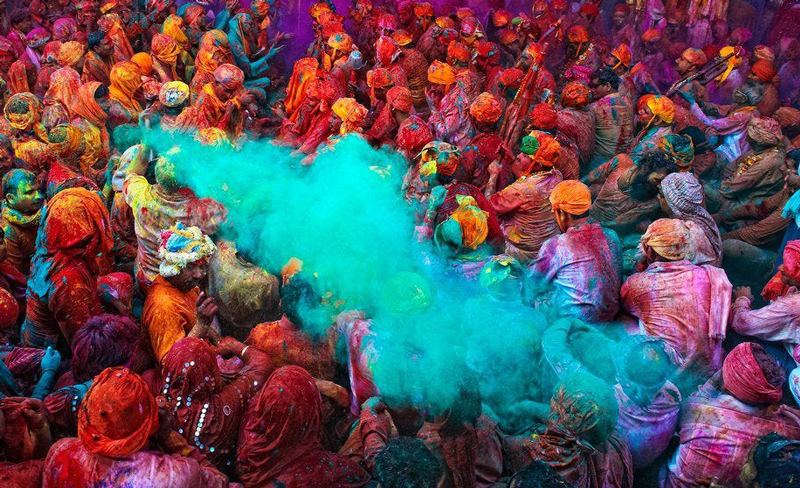Colors have a remarkable way of influencing our emotions, perceptions, and cultural beliefs. They transcend language barriers, communicating feelings and meanings across diverse societies. From vibrant celebrations to somber rituals, colors play an integral role in shaping cultures around the world. In this article, we delve into the fascinating world of color symbolism, exploring how different hues carry profound cultural significance.
Colors have a unique way of transcending verbal communication and conveying emotions. In various cultures, colors hold a deep-rooted symbolism that goes beyond the visible spectrum. They are intertwined with religious practices, cultural customs, and societal norms. This article takes you on a captivating journey through the intricate tapestry of color significance around the world.
The Language of Colors
Colors are a universal language that speaks directly to our senses. They evoke emotions, trigger memories, and shape our perceptions. From the calming allure of a serene blue sky to the passionate energy of a fiery red sunset, colors have the power to connect us with our surroundings and each other.
Colors in Religion and Spirituality
Color Symbolism in Christianity
In Christianity, colors hold profound symbolic meanings, often used in liturgical vestments and decorations. For instance, white symbolizes purity and holiness, often worn during religious celebrations. Purple signifies penance and preparation, seen during the season of Lent.
The Sacred Colors of Hinduism
Hinduism assigns deep significance to colors in rituals and festivals. Saffron represents purity and spirituality, while red symbolizes sensuality and purity. Blue is associated with the divine, representing the god Krishna, while green represents life and happiness.
Colors in Buddhism: A Journey to Enlightenment
Buddhism embraces colors as a means of spiritual enlightenment. The saffron robes of monks signify humility and detachment from material desires. White represents purity, and blue symbolizes the healing nature of the Buddha’s teachings.
Cultural Associations of Primary Colors
The Passion and Power of Red
Red’s symbolism varies widely across cultures. It can evoke feelings of passion and love, but also danger and anger. In Chinese culture, red is associated with luck and prosperity, while in Western cultures, it often represents romance.
The Many Faces of Blue
Blue’s meanings range from tranquility and serenity to sadness and melancholy. In Greek culture, blue represents protection against evil, while in the art world, it embodies depth and mystery.
Yellow: Joy, Wisdom, and Betrayal
Yellow carries diverse connotations, symbolizing joy and happiness in many cultures. However, it can also represent betrayal and cowardice. In China, yellow was reserved for emperors, symbolizing power and wisdom.
Secondary Colors: Blending Meanings
Green: Nature, Growth, and Envy
Green’s significance spans nature, growth, and renewal. In Islam, it’s a color of paradise, while in other contexts, it’s associated with envy. Green’s dual nature reflects its complex symbolism.
Orange: From Vibrancy to Spirituality
Orange exudes vibrancy and energy, often symbolizing enthusiasm and determination. In Hinduism, it represents fire and purity, while in Western cultures, it’s associated with autumn and change.
Purple: Royalty, Spirituality, and Mystery
Purple’s rich history encompasses royalty, spirituality, and mystery. In ancient Rome, it symbolized social status, while in Christianity, it represents penance and mourning.
Cultural Perspectives on Neutral Colors
White: Purity, Beginnings, and Mourning
White holds contrasting meanings across cultures. It signifies purity in weddings and new beginnings, yet it’s also associated with mourning in some Eastern cultures.
Black: Mourning, Power, and Modernity
Black’s symbolism is as diverse as its uses. It represents mourning in many cultures, but also signifies power, elegance, and modernity. It’s a canvas for creativity and mystery.
Gray: Ambiguity and Modesty
Gray embodies ambiguity and modesty, often representing compromise and neutrality. It’s a color of balance, finding harmony between contrasting meanings.
Global Festivals of Color
Holi: India’s Festival of Colors
Holi, the Hindu festival of colors, is a jubilant celebration of spring. Participants throw colored powders and water at each other, breaking down social barriers and fostering unity.
Dia de los Muertos: Celebrating Life and Death
In Mexico, Dia de los Muertos is a vibrant celebration of life and death. Vibrant colors honor deceased loved ones, reflecting the belief that death is a natural part of the human experience.
Carnival: A Spectrum of Joy
Carnival, celebrated in many countries, is a riot of colors, music, and dance. It’s a time of liberation and exuberance, embodying the spirit of celebration.
Colorful Idioms and Expressions
Language is rife with idioms that vividly illustrate the cultural nuances of colors. Phrases like “feeling blue” or “green with envy” demonstrate how colors encapsulate complex emotions and experiences.
The Psychology of Color Perception
The study of color psychology delves into how colors affect human behavior and emotions. Warm colors like red and yellow can stimulate appetite and evoke excitement, while cool colors like blue and green evoke calmness and relaxation.
Color’s Influence on Marketing and Branding
Colors are potent tools in marketing and branding. Brands use specific colors to evoke desired emotions and associations. For instance, red can create a sense of urgency, while blue conveys trust and reliability.
Cross-Cultural Color Misperceptions
Color perception isn’t always universal. Cultural differences can lead to variations in color interpretation. For instance, while Western cultures associate white with purity, some Eastern cultures link it to death and mourning.
Colors in Contemporary Art and Fashion
Artists and designers continue to push the boundaries of color expression. Contemporary art and fashion challenge traditional color associations, creating new dialogues between colors and cultural contexts.
Preserving and Adapting Color Traditions
In a globalized world, preserving cultural color traditions becomes essential. As societies evolve, adapting these traditions ensures they remain relevant, bridging the gap between heritage and modernity.
The Fluidity of Color Symbolism
Color symbolism is fluid, adapting to societal changes and individual perspectives. As cultures intertwine and evolve, colors continue to shape and reflect the intricate tapestry of our shared human experience.
Conclusion
Colors are more than visual sensations; they’re vessels of culture, history, and emotion. The significance of colors varies across cultures, illustrating the diversity and unity of humanity. From ancient rituals to contemporary expressions, colors enrich our lives, connecting us to our past and guiding us into the future.
FAQs
1. Are color meanings universal or culture-specific?
Color meanings often have universal elements, but cultural contexts can lead to variations in interpretation.
2. How do colors impact our emotions?
Colors have a psychological impact on emotions, triggering feelings of happiness, sadness, excitement, and more.
3. Can colors influence consumer behavior?
Yes, colors play a significant role in influencing consumer perceptions, emotions, and purchasing decisions.
4. Why do different cultures associate the same color with different meanings?
Cultural experiences and historical contexts shape how colors are interpreted and assigned meanings.
5. How can we appreciate and respect color symbolism from different cultures?
To appreciate color symbolism, it’s important to learn about the historical, religious, and cultural contexts that shape its meanings.














